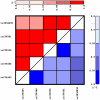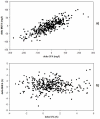Influence of FADS polymorphisms on tracking of serum glycerophospholipid fatty acid concentrations and percentage composition in children
- PMID: 21818279
- PMCID: PMC3144869
- DOI: 10.1371/journal.pone.0021933
Influence of FADS polymorphisms on tracking of serum glycerophospholipid fatty acid concentrations and percentage composition in children
Abstract
Background: Tracking of fatty acid (FA) contribution to plasma or serum lipids over time was shown in children and adults. However, the potential role of FADS gene variants has not been investigated.
Methods and principal findings: Serum GP FA composition of 331 children aged 2 and 6 years, participating in an ongoing birth cohort study, was analyzed. Correlation coefficients were estimated to describe FA tracking over 4 years and to assess the influence of FADS variants on tracking. We found low to moderate tracking (r = 0.12-0.49) of FA compositions and concentration between 2 and 6 years. Concentration changes of total monounsaturated FA and total saturated FA over time correlated closely (r = 0.79) but percentage values were unrelated (r = -0.02). Tracking for n-6 long chain polyunsaturated fatty acid (LC-PUFA) concentrations was lower in subjects homozygous for the major allele of FADS variants and higher in carriers of at least one minor allele, whereas for total n-3 LC-PUFA concentrations and compositions this was vice versa. For individual n-3 PUFA inconsistent results were found.
Conclusions and significance: Serum GP FA composition shows low to moderate tracking over 4 years with a higher tracking for LC-PUFA metabolites than for their precursor FA. Serum PUFA levels and their tracking seem to be more influenced by lipid and lipoprotein metabolism than by FA specific pathways.
Conflict of interest statement
Figures



References
-
- Baylin A, Campos H. The use of fatty acid biomarkers to reflect dietary intake. Curr Opin Lipidol. 2006;17:22–27. - PubMed
-
- Harris WS, Von Schacky C. The Omega-3 Index: a new risk factor for death from coronary heart disease? Prev Med. 2004;39:212–220. - PubMed
-
- Hodge AM, English DR, O'Dea K, Sinclair AJ, Makrides M, et al. Plasma phospholipid and dietary fatty acids as predictors of type 2 diabetes: interpreting the role of linoleic acid. Am J Clin Nutr. 2007;86:189–197. - PubMed
-
- Crowe FL, Allen NE, Appleby PN, Overvad K, Aardestrup IV, et al. Fatty acid composition of plasma phospholipids and risk of prostate cancer in a case-control analysis nested within the European Prospective Investigation into Cancer and Nutrition. Am J Clin Nutr. 2008;88:1353–1363. - PubMed
-
- von Schacky C. Omega-3 fatty acids and cardiovascular disease. Curr Opin Clin Nutr Metab Care. 2007;10:129–135. - PubMed
Publication types
MeSH terms
Substances
LinkOut - more resources
Full Text Sources

